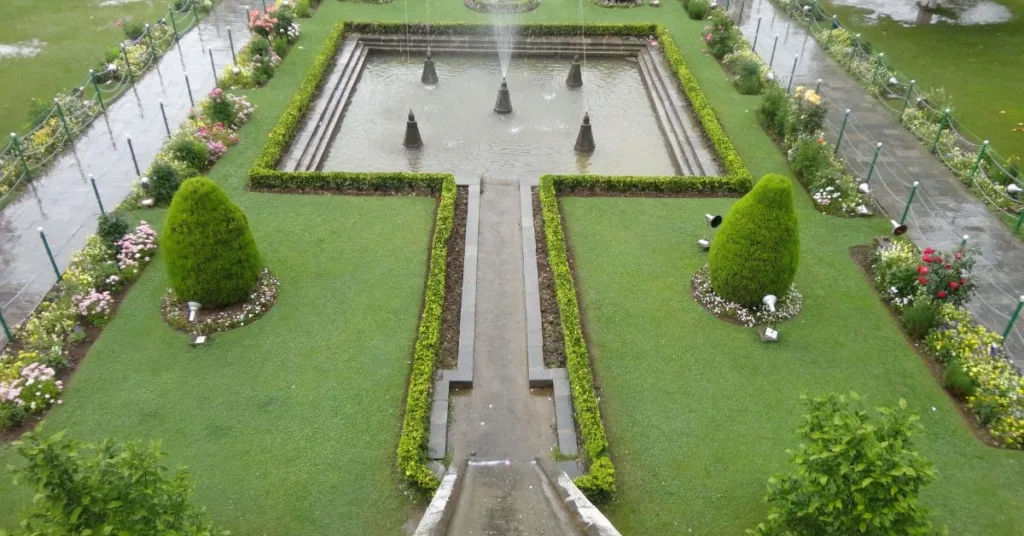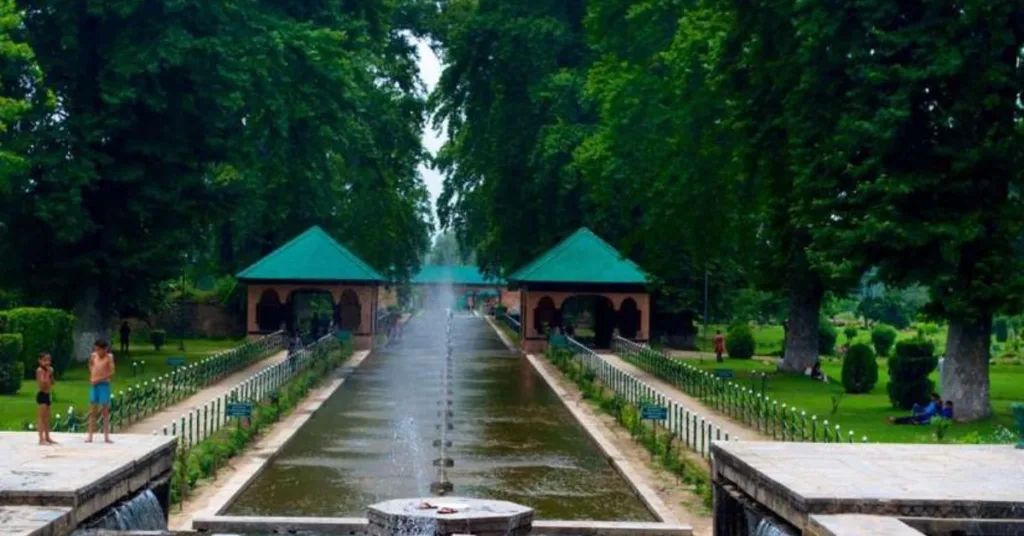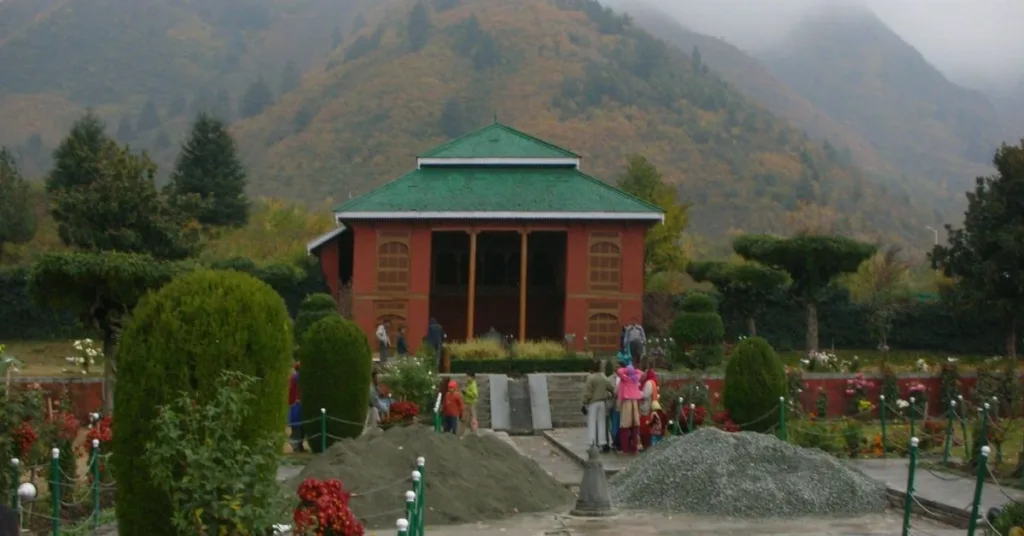The Mughal Gardens of Jammu & Kashmir are stunning examples of Mughal horticultural art. These gardens are located in beautiful landscapes and show the grandeur of Mughal design. With their intricate layouts, cascading fountains, and lush greenery, they offer a peaceful escape from the heat of the plains.
Each garden tells a story of royal luxury and provides a serene setting in the Himalayas. From the famous Shalimar Bagh and Nishat Bagh to the lesser-known Chashme Shahi, these gardens show the refined tastes and careful planning of the Mughal era. They feature terraced lawns, vibrant flowers, and tranquil water features, creating a perfect place for relaxation and reflection.
How to reach:
1. By Air:
The most convenient way to reach Srinagar is by air. Sheikh ul-Alam International Airport is well-connected to major Indian cities. From the airport, you can take a taxi or local transport to the Mughal Gardens, which are about 15-20 kilometers away.
2. By Train:
Take a train to Jammu Tawi Railway Station, and then continue your journey to Srinagar by road. The drive takes around 6-8 hours. Buses and taxis are readily available.
3. By Road:
Drive from Delhi or other major cities to Srinagar, though the journey can be long. The route offers stunning views. Alternatively, take a bus.
4. Local Transport:
Once in Srinagar, the Mughal Gardens are easily accessible by local taxis, auto-rickshaws, or rental cars. Srinagar has a well-developed network of local transport.
5. Guided Tours:
Book a guided tour for a convenient experience. Many tour operators offer packages that include transportation and guided tours.
Best time to visit:
1. Spring (March to May):
Spring is the ideal time to visit the Mughal Gardens. The gardens are in full bloom, the weather is mild, and the lush greenery and colorful flowers create a stunning display.
2. Summer (June to August):
Summer is another good time to visit, with warm and pleasant weather. However, it’s also the peak tourist season, so expect more crowds and higher prices.
3. Autumn (September to November):
Autumn offers a beautiful and less crowded experience. The weather is crisp and cool, and the changing leaves create a stunning landscape.
4. Winter (December to February):
Winter brings a magical charm to the gardens with snowfall. However, some gardens may be closed due to snow. If you enjoy snowy landscapes and a quieter atmosphere, winter can be a great time to visit, but be prepared for cold temperatures and possible travel disruptions.
Attractions:
Nishat Bagh:

Nishat Bagh, which means “Garden of Joy,” is a beautiful Mughal Garden located on the eastern side of Dal Lake. It was built by Emperor Shah Jahan for his sister.
The garden has cascading terraces and well-maintained lawns. As you walk down the terraces, you’ll have amazing views of the mountains and Dal Lake. The central canal is decorated with fountains and colorful flower beds. Nishat Bagh is famous for its beautiful flowers and peaceful atmosphere.
Shalimar Bagh:
Shalimar Bagh is one of the most famous Mughal Gardens. It was built by Emperor Jahangir for his wife, Empress Nur Jahan. The garden has beautiful terraces, colorful flower beds, and cascading water channels.
The garden is known for its amazing design, which includes a grand canal running through the center. The Mughal architecture, with its intricate pavilions and fountains, adds to its beauty. The highest terrace, called “Farah Baksh,” offers stunning views of the surrounding area, making it a popular spot for visitors.

Chashme Shahi:

Chashme Shahi, which means “The Royal Spring,” is the smallest of the Mughal Gardens but still very beautiful. It was built by Emperor Shah Jahan in 1632. The garden is known for its terraced layout and the natural spring that flows through it.
The garden has a central water channel that flows down the terraces, with lush greenery and colorful flowers along the paths. The cool, clear water of the spring is believed to have healing properties. The peaceful atmosphere and amazing views of Srinagar make it a great place for visitors to relax.
Local Experiences:
- Shikara Rides: Enjoy a serene boat ride on Dal Lake for picturesque views of the Mughal Gardens from the water.
- Local Cuisine: Savor traditional Kashmiri dishes like Rogan Josh, Yakhni, and Kehwa at local restaurants or houseboats.
- Handicraft Shopping: Explore local markets for unique Kashmiri handicrafts, such as Pashmina shawls and woolen garments.Photography and Painting: Capture the stunning beauty of the gardens through photography or painting.
- Cultural Performances: Attend traditional cultural performances and folk dances.
- Guided Tours: Take guided tours to learn about the history and design of the gardens.
- Seasonal Flower Festivals: Enjoy the annual Tulip Festival in spring.
- Visit Local Temples and Shrines: Explore nearby religious sites to gain a deeper understanding of the region’s cultural and spiritual landscape.Picnicking: Enjoy a peaceful picnic amidst the lush greenery of the gardens.
- Botanical Insights: Discover the various plant species and horticultural techniques used in the gardens.
- Local Craft Workshops: Participate in workshops that showcase traditional Kashmiri crafts.
- Evening Strolls: Take leisurely evening strolls through the gardens to enjoy the tranquil ambiance.
Travel tips:
- Plan Ahead: Check opening hours and seasonal closures.
- Dress Comfortably: Wear comfortable clothing and shoes. Consider layering for variable weather.
- Carry Essentials: Bring sunscreen, a hat, sunglasses, and a water bottle.
- Respect Local Customs: Be mindful of local customs and dress modestly.
- Use Sun Protection: Apply sunscreen regularly and wear a hat and sunglasses.
- Check Weather Forecasts: Be prepared for rain or sudden temperature drops.
- Travel Light: Keep your luggage light and manageable.
- Stay Hydrated: Drink plenty of fluids.
- Respect the Environment: Avoid littering and stay on designated paths.
- Be Cautious with Food and Water: Stick to bottled or filtered water and eat at reputable establishments.
- Book Accommodations in Advance: Reserve your accommodations early.
- Carry Cash: Carry some cash for purchases and tips.
- Check for Local Festivals: Align your visit with local festivals for a more enriching experience.
- Hire a Local Guide: Gain deeper insights into the history and significance of the Mughal Gardens and navigate the area more easily.
Conclusion
The Mughal Gardens of Jammu & Kashmir are more than just historical sites; they’re living legacies of grandeur, artistry, and opulence. Each garden, from the serene Shalimar Bagh to the majestic Pari Mahal, offers a unique glimpse into a Mughal emperor’s vision of paradise. Explore meticulously designed gardens with cascading terraces, vibrant flowers, and tranquil water features, all while immersing yourself in the region’s rich culture and history. From local cuisine to traditional crafts, the Mughal Gardens offer diverse experiences for every traveler. Let Xplro.com (your one-stop guide to unforgettable travel experiences) help you plan your visit and ensure a memorable journey through time, beauty, and serenity.
FAQs
1. What are the Mughal Gardens in Jammu & Kashmir?
- The Mughal Gardens in Jammu & Kashmir are a collection of historic gardens established by Mughal emperors in the region. They are renowned for their architectural beauty, including terraced levels, flowing water channels, and lush flowerbeds. Notable gardens include Shalimar Bagh, Nishat Bagh, Chashme Shahi, and Pari Mahal.
2. When is the optimal time to visit the Mughal Gardens?
- The ideal times to visit the Mughal Gardens are during spring (March to May) and autumn (September to November). Spring brings vibrant floral displays, while autumn offers cooler temperatures and beautiful changing foliage. Summer (June to August) is also a good time but tends to be more crowded, and winter (December to February) can be cold with potential snow.
3. How can I get to the Mughal Gardens?
- To reach the Mughal Gardens, travel to Srinagar. You can fly into Sheikh ul-Alam International Airport in Srinagar. Alternatively, take a train to Jammu and then drive to Srinagar. Within Srinagar, you can use taxis, auto-rickshaws, or guided tours to reach the gardens.
4. Are the Mughal Gardens open throughout the year?
- Most Mughal Gardens are open year-round, but access can be limited during winter due to snow or extreme weather. It’s a good idea to check current conditions and garden accessibility before your visit.
5. What should I wear when exploring the Mughal Gardens?
- Opt for comfortable clothing and footwear suitable for walking. Depending on the season, dress in layers to accommodate varying weather conditions. Also, consider bringing a hat, sunglasses, and sunscreen for sun protection.
6. Is there an entry fee for the Mughal Gardens?
- Yes, there is usually an entry fee for the Mughal Gardens, which can vary depending on the garden and whether you are a domestic or international visitor. Check the current fee structure before your visit.
7. Can I take photos at the Mughal Gardens?
- Photography is generally permitted at the Mughal Gardens, but be mindful of other visitors and avoid using flash or tripods in crowded areas. Some gardens may have restrictions on commercial photography.
8. Are guided tours available for the Mughal Gardens?
- Yes, guided tours are offered for the Mughal Gardens. These tours provide detailed information about the gardens’ history, design, and significance. You can book tours through local operators or hotels in Srinagar.
9. What local experiences can I enjoy near the Mughal Gardens?
- Nearby experiences include taking a Shikara ride on Dal Lake, enjoying traditional Kashmiri dishes, exploring local handicraft markets, watching cultural performances, and participating in craft workshops.
10. Are there dining options close to the Mughal Gardens?
- Yes, there are several dining options around the Mughal Gardens. You can find a range of restaurants offering local Kashmiri cuisine, from casual eateries to fine dining establishments.
11. Is it safe to visit the Mughal Gardens?
- The Mughal Gardens are generally safe for tourists. However, stay updated on local conditions, follow safety advice, and exercise typical travel precautions, especially in unfamiliar areas.
12. Can I see all the Mughal Gardens in one day?
- Visiting all the major Mughal Gardens in a single day can be difficult due to their size and the time required to explore each one. It is better to plan for at least one day per garden or spread your visit over several days to fully appreciate each location.






